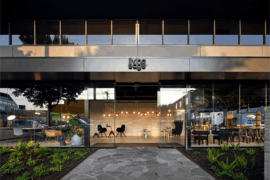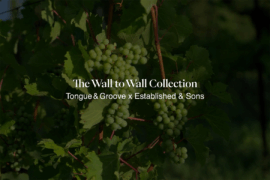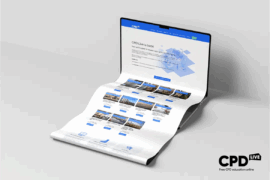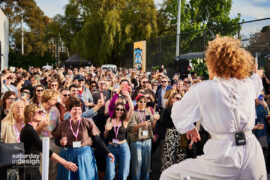BLOC by David Caon for Living Edge is a line of customisable, modular office furniture that pre-dates COVID-19 by years, and yet its inherent flexibility and emphasis on focused work renders it perfectly suited for offices transitioning from open plan to safely separated.

Photography by Peter Clarke Photography
March 2nd, 2021
The design industry is one that’s built its reputation on innovation, adaptability and flexibility. At no time has this felt more prevalent, or indeed pressing, than right now. Less than 12 months ago an architect or interior designer would be hard pressed to find a brief for a workplace that wasn’t largely open plan, with a few concessions for breakout spaces aimed at independent work. Facilitating collaboration has long been understood a key contributor to success – whichever industry you may be in.
But the future of the open-plan office is rife for debate and professionals across the world are making predictions based on various contingencies: and yet the only thing we know for sure is that nothing is certain.
The Times, They Are A-Changin’ and who knows how long and to what extend this “new normal” way of working will stick around. David Caon’s BLOC and BLOC+ line of modular furniture designed for Living Edge pre-dates COVID-19 by four years, and yet it applies perfectly to the new needs of the office; a key example of the flexibility and adaptability for which Australian design has long been touted.

Photography by CAON Studio
For now, any return to the office will need to be met with max personnel capacities and adequate social distancing. BLOC is highly customisable to meet the needs of large and small-scale projects while the collection itself is comprehensive, ranging from independent workstations, collaborative working and meeting environments, and social spaces.
“The product has always been about creating intimate spaces for work within more open environments and as such it is well suited to help clients deal with COVID,” says Caon. The freestanding Focus Desk, Executive Suite and Staggered Triple Desk Booth are the key workstation designs that were initially celebrated for their ability to subtly and stylishly isolate employees for focused work. Now, they offer added benefits of clearly demarcated individual work zones and panels and partitions as added barriers against airborne particles. By extension, the collaborative working and social spaces pieces feature generously spaced seating, high backrests and partitions disguised as shelving.

Photography by CAON Studio
But in addition to office reconfigurations there are new challenges for designers to which innovation rather than adaptability seems best suited. One of those challenges, as Caon identifies, is the WFM phenomenon: although hardly a new concept this time around it has taken on a new life. Companies that were previously hesitant to separate their workforce have been forced to do so and the pros and cons are neck-a-neck and highly personal. As such it’s likely that many companies will continue to offer this flexibility in some form into the future.
Whether the home working environment falls under the responsibility of the employer or the employee, designers are faced with a new need for ergonomic furniture that suits a residential environment. “A well designed home office will bolster productivity and creativity when working from home, so designers may want to consider what is happening for the staff beyond the front door of the building,” says Caon.
Although available in multiple configurations, BLOC has always been available to custom design tweaks to suit the most unique environments. The design team pays careful attention to what clients are requesting: in many cases it serves to highlight the uniqueness of a particular company, other times it can be indicative of gaps in the market and the evolution of consumer needs. The Pandemic is one accelerated example. While some people working form home are lucky to have dedicated spaces to do so, many are doing so from dining tables, kitchen benches, bedrooms and other ill-suited areas of the home due to space or circumstance.

Photography by CAON Studio
“The Pandemic has forced me to think about how BLOC or other products could contribute to making things better for people who may have to work from home occasionally,” says Caon. “While BLOC is able to help solve the problems of the new normal within offices, perhaps it can make a difference when working from home too.”
One of the pillars of BLOC and BLOC+ has been to create modular, customisable designs to empower the end user. The pieces within the collection can be configured in any number of ways to suit small and large spaces alike, as well as the diverse needs from one company to the next. As the dimensions and indeed reach of the office evolves, David Caon and his design team at BLOC are dedicated to keeping a keen eye on the market in order to provide design-led, solution-driven, highly functional furniture.
INDESIGN is on instagram
Follow @indesignlive
A searchable and comprehensive guide for specifying leading products and their suppliers
Keep up to date with the latest and greatest from our industry BFF's!

A longstanding partnership turns a historic city into a hub for emerging talent

For Aidan Mawhinney, the secret ingredient to Living Edge’s success “comes down to people, product and place.” As the brand celebrates a significant 25-year milestone, it’s that commitment to authentic, sustainable design – and the people behind it all – that continues to anchor its legacy.
The new range features slabs with warm, earthy palettes that lend a sense of organic luxury to every space.

London-based design duo Raw Edges have joined forces with Established & Sons and Tongue & Groove to introduce Wall to Wall – a hand-stained, “living collection” that transforms parquet flooring into a canvas of colour, pattern, and possibility.

The final day of CPD Live’s 2025 season delivers three must-attend sessions exploring circular design for furniture and fitouts, and the science behind safe, high-quality drinking water. Starting from 9 AM AEDT, 16th October – it’s your last opportunity this year to join our Live CPD sessions and finish 2025 inspired.

Richmond came alive for Saturday Indesign 2025 as showrooms, rooftops and laneways transformed into a celebration of design, creativity and connection.
The internet never sleeps! Here's the stuff you might have missed

Where style and substance truly dwell, Gardam’s latest modular collection – available through Stylecraft – balances elegance and versatility.

At Moonee Ponds Primary School, Clarke Hopkins Clarke’s transformative design uses Autex acoustic solutions to shape a calm and creatively charged learning environment.